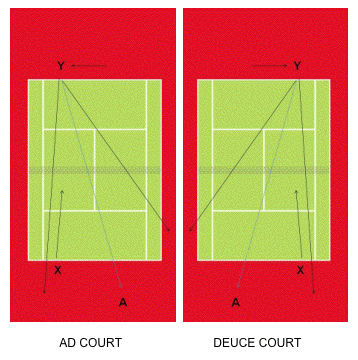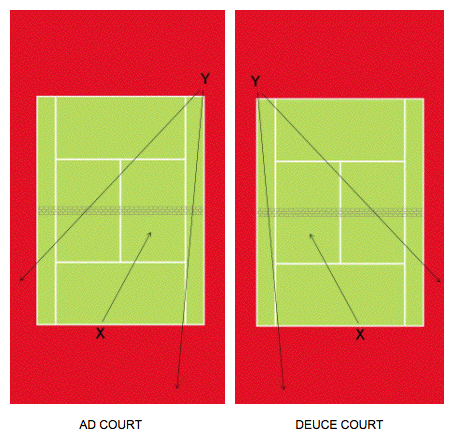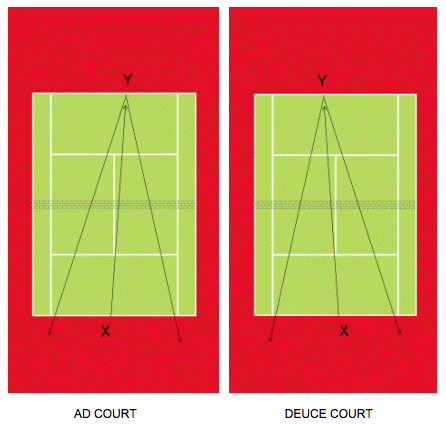July 2009 Article Turbo Tennis Archives:
Tennis Server
|

 |
The serve/volley and chip/charge styles of tennis normally appear only during grass tournaments like Wimbledon, and when the tournament is played on a fast surface like carpet. Let's face it. Most modern players are baseline oriented, and rarely move to the net unless forced to come to the net.  Often times, players with big groundstrokes are not able to hit the forehand, sliced approach shot with authority. If this applies to you, a sharply angled crosscourt approach that is hit with plenty of topspin will certainly work. Again, the geometry associated with this approach favors your hitting a good first volley. When coaching players, I frequently recommend that they approach the net using a one handed, backhand slice or a severely angled, topspin forehand. It is my experience that most groundstroke oriented players can hit both of these shots with proficiency. Of course, the serve is critically important when playing the net game. Players need to work on what I call their serve/volley serves. First, most of us hit our volleys using a continental grip. So, it makes perfect sense to hit the serve with this same grip. This grip usually is best for big, flat serves or for sliced serves. Using both of these serves and varying when you employ them is certainly helpful when trying to serve/volley on the first serve. My recommendation is to hit the big, flat serve down the T. While I would slice my first serves as wide as is possible. I find this "rule" to be applicable to both the Ad and Deuce courts. Between these two, I find that the slice serve wide is usually better for the less than comfortable net player. Why? Well first, your opponent is drawn wide to make a return. If she/he tries a down the line return, the ball has to travel over the highest part of the net and must land in the court with less margin for error. If the return is directed cross court, the server can usually be positioned in a manner that permits a fairly easy first volley to the open court. In addition, slice serves give the server more time to close the net. Granted, this may only be a fraction of a second, but this can make a big difference with respect to how close the server is able to get to the net when making his/her first volley. If you look at classic serve/volley, you will see that the wide, sliced serve is the norm for first serves. In the diagrams below, you can see the range of potential returns that the opponent (Y) has when you (X) slice your serve wide. You will note that your opponent is returning from near the outside of the doubles alley. Again by following the path of the ball, you are in an ideal position to cover all of these returns. Unlike approach shots in this case, the opponent may actually be equally likely to return down the line or crosscourt.  The big, flat serve is usually best hit down the line for two reasons. First, the opponent is normally reacting very quickly to this serve and has more difficulty in making a winning or strong return. Should he/she be able to anticipate this serve and return with authority, more often than not, the return will be placed somewhere near the center of the net. Thus, the server has a narrower area to cover in making her/his first volley. In the diagrams below, I have shown the down the T, flat serve. You will note that this serve offers a range of returns that puts the opponent (Y) in or around the center of her/his court. Thus, by following the serve's path, you (X) can best cover all of these potential returns.  Kick serves are normally the very best option when hitting a second serve. A kick serve has both topspin and a bit of slice. The ball bounces higher than normally is the case, and if there is some slice on the serve, the ball will bounce to one side. The kick serve is the norm for second serves on the pro tours regardless of whether the server intends on closing the net. This is because the high bouncing ball that spins to the side is a bit more difficult to put away for a clean winner. For the serve/volley player, the kick serve provides a bit of extra time to close the net. Again, this fraction of a second of extra time can make a significant difference with respect to how near to the net the server is when making her/his first volley. Quite frequently, the kick serve can be a useful first serve when attempting to play the net game. The great Stefan Edberg hit every serve as a kick serve. These serves coupled with his natural speed when closing the net provided him with an advantage for his serve/volley game. A problem with the kick serve is that it normally requires an eastern backhand grip. Thus, the serve/volley player must change grips to the continental grip after striking this type of serve. However, this is not a difficult change. I have actually learned to hit a kick serve using a continental grip. Thus, I am ready to strike a volley immediately after serving without having to change my grip. I grant you that my continental gripped kick serve does not have as much topspin as those hit with an eastern backhand grip. But, there is some kick, and almost any player can learn to kick serve with the continental grip... if he/she practices! When attempting the net game, the serve is struck while the body is moving forward. Many times, the baseline player will jump up when serving, but not really move forward into the court. If a player wants to serve/volley, she/he must learn to lean forward and move forward while serving. This motion is critically necessary to assist the player in closing the net after striking the serve. Given this, players need to practice serving for the serve/volley game. Using the normal, stay-back serve motion will not be helpful when attempting to serve/volley. Really, these are two very different motions. Moving to the net and learning to when to split step (or just stop the forward movement) is the next variable that needs to be explored. I remember watching Barbara Potter teach area players how to serve/volley. She would literally have them count one, two, three, and then, split step to make the first volley. I don't think that this is a bad technique, and certainly, Ms. Potter was a great serve/volley, tour player. For me however, this is a bit cumbersome to adopt. It may not be for you, and I encourage each reader to give this coaching technique a try. I prefer to have my entire focus upon the ball. I don't want to be thinking about my feet. Nor do I want to be counting steps. Rather, I split step (really simply stopping one's forward movement is sufficient) as soon as I see the ball touch my opponent's string. I have found that this almost always helps me to split step at precisely the right moment without having to take my focus off of the ball. Most of us seem to move directly toward the center of the net after we serve. I guess that the "center theory of coverage" which we use in baseline play wants to impose itself on the net game. Simply put, this center approach is not useful when serve/volleying or chip/charging. As stated above, the server should "follow the path of the ball" after hitting the serve. If the serve is wide, the server automatically shades a bit in this direction. If the ball is hit down the T, the server will naturally move to the center of the net. Here again, I find that this technique helps me to move properly without having to think. I can focus on the ball, which is the most important aspect in the game! This same rule of "follow the path of the ball" should be employed when chip/charging and after each volley! If you approach the net with a down the line shot, and follow the path of the ball, you will automatically find yourself in the best possible court position to cover any possible replies. If you approach with a severely angled, topspin approach, you will still automatically be in the ideal position. Many players freeze and do not move after hitting their first volley. Whether it is your first, second or third volley, you should always be moving forward a bit and shading in the direction of the ball's path after you strike the volley. By continuing to close the net after each volley, you make your next volley easier. The closer you are to the net, the likelihood of having to hit a low volley diminishes. By following, the direction of your volleys, you automatically put yourself in the ideal position to cover any reply. Always expect that you will need to hit another volley! I see many players who hit the first volley and expect that it will result in a winner. This may be the case, but quite frequently, our opponents find a way to hit a response to our "great" volley. Doubles players usually do not fall victim to this syndrome. They realize from playing doubles that there is always a possibility that the opponent will get to any volley struck. The chip/charge approach to return of serve is one that is a very underutilized in the modern game. Here, the return is hit with slice... down the line. The returner follows the path of the ball toward the net, and attempts to hit his/her next shot as a volley, or if necessary, as a half volley. The topspin, crosscourt return is not a wise choice for moving into the net off of the serve. Why? Well, the ball may bounce high enough and short enough that the fleet footed opponent may track your return down and put it away. So, let's review. First, one needs to have reliable volleys. In practicing volleys, do not stand close to the net! In all probability, you will not be hitting your first volley from such a close position. Rather, stand closer to the service line as you take practice volleys. This position is more realistic with respect to match play. If you can volley effectively from this deeper position, the volleys you hit when closer to the net will be no problem. If you are going to play a net game at some point, you will need to be able to hit a good approach shot. These transition shots are needed even if you do not intend on playing serve/volley or chip/charge. The baseliner who wishes to integrate some net game into her/his arsenal will need these approach shots to be well honed. The rule is relatively simple. Approach down the line with slice, and approach crosscourt with topspin. Each player should practice approach shots and discover which approaches work best off of each wing. In serve/volley tennis it is imperative that the player can serve effectively while moving forward to the net. These serves are not the same as serves hit when playing "stay back" tennis. Each player needs to practice forward moving serves that will be used in the serve/volley game. Serve spin and placement are critical in the serve/volley game. First serves should be hit generally in one of two ways: Slice wide or hit flat serves down the line. Of course, every once in a while it is worthwhile to hit a flat serve with pace directly at your opponent. These serves "jam" your opponent and can result in a weak return. These will work effectively on an intermittent level, but if one attempts to jam your opponent on every first serve, it will not take him/her long to realize this tactic and run around your serve. This frequently can result in the opponent hitting a winner off of her/his return. Second serves are usually best struck as kick serves when playing serve volley. Generally, they are best hit to the opponent's weaker wing. More often than not, this will be the backhand side. Movement in the net game needs to be natural but effective with respect to positioning. Following the path of the ball in the net game is a requirement, if one is to keep mental focus on the ball while moving to strategic positions on the court. This rule applies to serves, chipped returns, approach shots and movement after hitting volleys. A great way to help you become a better net player is to incorporate playing doubles into your practice and tournament schedules. I always admired the fact that John McEnroe played both singles and doubles during the height of his career. Each of these, in my mind, helped him perform better in the other. Mastering the net game will take some time and a bit of deliberate dedication. But, it is an essential option to have when playing singles. Should you take the time to integrate the net game into your tactical arsenal, I am sure that it will help you to become a tennis overdog!
1996 - 2002 | 2003 - Present
This column
is copyrighted by Ron Waite, all rights reserved. Questions and comments
about these columns can be directed to Ron by using this form.
Ron Waite is a certified USPTR tennis instructor who took up the game
of tennis at the age of 39. Frustrated with conventional tennis methods
of instruction and the confusing data available on how to learn the
game, Ron has sought to sift fact from fiction. In his seven years of
tennis, Ron has received USTA sectional ranking four years, has successfully
coached several NCAA Division III men's and women's tennis teams to
post season competition, and has competed in USTA National singles tournaments.
Ron has trained at a number of tennis academies and with many of the
game's leading instructors.
In addition to his full-time work as a professor at Albertus Magnus
College, Ron photographs ATP tour events for a variety of organizations
and publications. The name of his column, TurboTennis, stems from his
methods to decrease the amount of time it takes to learn and master
the game of tennis.
|



October 2022 Tennis Anyone: Patterns in Doubles by John Mills. September 2022 Tennis Anyone: Short Court by John Mills. |
 You will join 13,000 other subscribers in receiving news of updates to the Tennis Server along with monthly tennis tips from tennis pro Tom Veneziano.
You will join 13,000 other subscribers in receiving news of updates to the Tennis Server along with monthly tennis tips from tennis pro Tom Veneziano. 